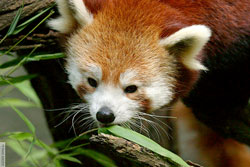|
Nutrition |
|
Red pandas are crepuscular animals, meaning they are active at dawn
and dusk. During their active period, which consists of
approximately 8 hours each day, they spend their time wandering
through bamboo forests and feeding. They feed on bamboo leaves, lichens, plant roots, fruits,
seeds, and acorns; however, they will occasionally eat bird eggs, young birds,
insects, and grubs. |
|
Although red pandas feed on a number of things, they feed
primarily on
bamboo. In fact, red pandas are often called folivores or leaf eaters
because of this. Interestingly, they select bamboo leaves with great care.
Usually, the red panda will nip off the leaf at a specific point, most likely
the junction between the leaf and the branch. Also, red pandas are not
willing to eat dead or partially dead leaves. |
| Unlike other herbivores, or plant-eating animals, red pandas do not have a gut that is able to break down the energy-rich cellulose that makes up the cell walls of bamboo. In fact, red pandas do not have micro-organisms, such as bacteria, living in their gut, breaking down the indigestible plant cell walls as seen in the majority of herbivores. Instead, red pandas have developed different adaptations that make the digestion of bamboo possible. First, they have teeth which are modified for crushing leaves. Although their incisors and canines look like the teeth of a carnivore, their premolars and molars are able to crush and grind leaves. Therefore, their teeth allow them to chew their food thoroughly and enable them to digest more of the bamboo's cell content. In addition to modified teeth, their body size is another adaptation that helps with the consumption of bamboo. Their body size enables them to consume a large, leafy diet. Because red pandas have low-energy requirements, they are able to survive on bamboo, which is a low-energy food source. |

